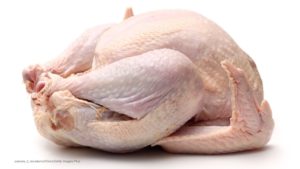As we all know, poultry products are often contaminated with bacteria. In fact, uncooked poultry is one of the most common sources of harmful bacteria found in food. That’s why you never see a recipe for “medium well done” chicken. The flesh of the chicken is porous enough that bacteria on its surface can penetrate all the way through the flesh. Cook your chicken well-done and the bacteria are destroyed.
 Unfortunately, improper handling of raw chicken is a prime cause of cross-contamination. The chicken’s surface contains a high number of disease-causing bacteria. Juices splatter during food preparation, and slight contact with raw chicken can easily contaminate utensils, countertops, and ready-to-eat foods. To help reduce the incidence of foodborne illness caused by cross-contamination in the consumer kitchen, scientists have been researching ways to reduce bacteria levels on chicken.
Unfortunately, improper handling of raw chicken is a prime cause of cross-contamination. The chicken’s surface contains a high number of disease-causing bacteria. Juices splatter during food preparation, and slight contact with raw chicken can easily contaminate utensils, countertops, and ready-to-eat foods. To help reduce the incidence of foodborne illness caused by cross-contamination in the consumer kitchen, scientists have been researching ways to reduce bacteria levels on chicken.
In a research report conducted by the A.J. Drexel Plasma Institute at Drexel University, published in the Journal of Food Protection, scientists have found that nonthermal, or cold, plasma treatments can reduce the level of pathogenic bacteria on poultry surfaces.
This high-energy gas is called the “fourth state of matter” since it’s a charged mix of electronics, atoms, and ions. Plasma is a good method for reducing pathogens because it doesn’t cook the food. In fact, scientists are also testing plasma treatment methods for reducing bacterial counts on produce, which is often eaten raw.
The study looked at Salmonella and Campylobacter because they are the most common bacteria found on chicken. Removing these bacteria from poultry’s surfaces before it reaches the consumer’s kitchen could reduce foodborne illness outbreaks.
In the study, chicken was inoculated with antibiotic resistant strains of Salmonella enterica and Campylobacter jejuni, then exposed to plasma. The surviving bacteria were recovered and counted. The plasma treatment eliminated low levels of Salmonella enterica and Campylobacter jejuni from skinless chicken breasts and the chicken skin.
When the bacterial counts were high, the plasma treatment significantly reduced their level. The study found that antibiotic-resistant bacteria were just as susceptible to plasma treatment as non-antibiotic-resistant bacteria, also known as “wild-type” strains. The treatment may someday be used to extend the shelf life of raw poultry and other meats.
Unfortunately, at this time plasma technology is quite expensive so it’s not economically feasible to use it in factories, or in your home kitchen. So remember to follow food safety rules: Don’t rinse chicken before you cook it, since that will scatter bacteria around the sink and the kitchen. Cook the chicken thoroughly, wash your hands before and after handling raw chicken, avoid cross-contamination, and thoroughly clean all utensils, cutting boards, countertops, and pots and pans that come into contact with raw chicken.




